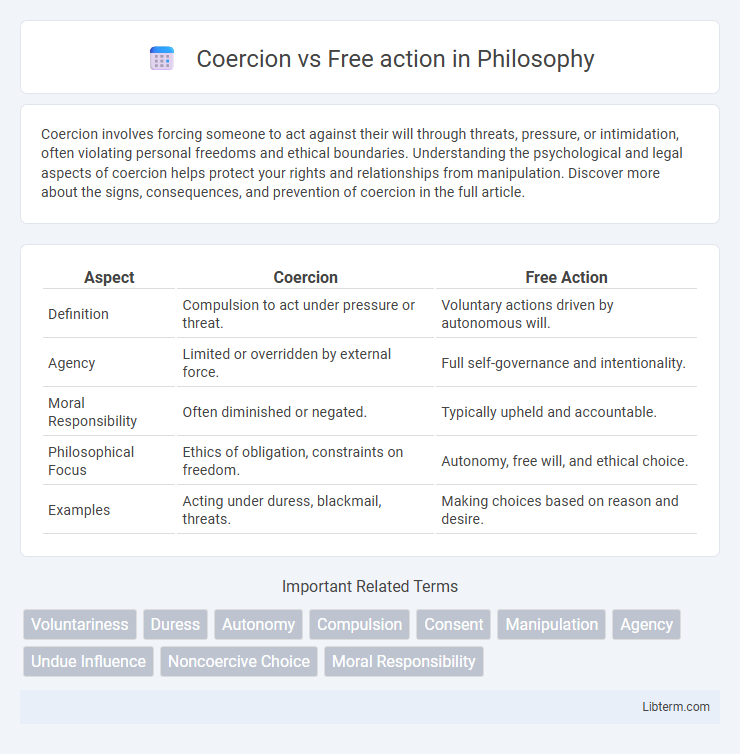Coercion involves forcing someone to act against their will through threats, pressure, or intimidation, often violating personal freedoms and ethical boundaries. Understanding the psychological and legal aspects of coercion helps protect your rights and relationships from manipulation. Discover more about the signs, consequences, and prevention of coercion in the full article.
Table of Comparison
| Aspect | Coercion | Free Action |
|---|---|---|
| Definition | Compulsion to act under pressure or threat. | Voluntary actions driven by autonomous will. |
| Agency | Limited or overridden by external force. | Full self-governance and intentionality. |
| Moral Responsibility | Often diminished or negated. | Typically upheld and accountable. |
| Philosophical Focus | Ethics of obligation, constraints on freedom. | Autonomy, free will, and ethical choice. |
| Examples | Acting under duress, blackmail, threats. | Making choices based on reason and desire. |
Understanding Coercion: Definition and Key Features
Coercion refers to the act of compelling an individual to act against their will through threats, force, or intimidation, undermining their ability to make voluntary decisions. Key features include the presence of undue pressure, loss of autonomy, and the absence of genuine consent, distinguishing coercion from free action. Understanding these elements is crucial for recognizing situations where personal freedom is compromised and actions are not freely chosen.
Defining Free Action in Philosophy and Ethics
Free action in philosophy and ethics is defined as behavior performed voluntarily and intentionally without external compulsion or coercion. It involves autonomous decision-making grounded in an agent's rational capacities and reflective endorsement of motives. This concept is essential for moral responsibility, asserting that only actions stemming from free will can be deemed ethically praiseworthy or blameworthy.
The Spectrum Between Coercion and Freedom
The spectrum between coercion and free action highlights the varying degrees of autonomy individuals experience in decision-making processes, ranging from complete compulsion to full voluntary choice. Factors influencing this continuum include psychological pressure, social influence, and legal constraints, which can limit or enhance personal freedom. Understanding this spectrum is essential in fields like ethics, law, and social science to evaluate the legitimacy and moral weight of actions performed under different levels of coercion.
Psychological Impacts of Coercion
Coercion significantly disrupts psychological well-being by inducing chronic stress, anxiety, and a diminished sense of autonomy. Victims often experience feelings of helplessness and lowered self-esteem, which can lead to long-term mental health issues such as depression and post-traumatic stress disorder (PTSD). The ongoing psychological impact of coercion undermines free action by impairing decision-making abilities and fostering learned helplessness.
Legal Perspectives: When Is Action Truly Voluntary?
Legal perspectives on coercion versus free action hinge on the presence of undue pressure or threats undermining an individual's autonomy, rendering consent involuntary. Courts analyze the circumstances surrounding the decision, such as force, intimidation, or manipulation, to determine if an action was genuinely voluntary. The threshold for voluntariness often depends on whether a reasonable person would have felt free to choose otherwise under similar conditions.
Historical Examples of Coercion vs Free Action
Historical examples of coercion include the forced labor systems in ancient Egypt and the servitude imposed on indigenous populations during European colonization, where individuals were compelled to act against their will under threat of punishment. In contrast, free action is exemplified by watershed moments like the signing of the Magna Carta in 1215, which marked a step toward limiting authoritarian rule and establishing individual rights. The American Revolution further illustrates free action, where colonists collectively chose to rebel against British coercive laws, emphasizing self-governance and voluntary political participation.
The Role of Power Dynamics in Decision-Making
Power dynamics critically shape decision-making processes by influencing whether actions are genuinely free or coerced, as individuals under significant authority pressure often comply to avoid negative consequences. Coercion undermines autonomy by limiting alternatives and manipulating incentives, whereas free action occurs in contexts where individuals can make choices without undue influence or fear of retaliation. Understanding these dynamics is essential for analyzing legal responsibility, ethical accountability, and the legitimacy of consent in social, political, and organizational settings.
Ethical Implications: Morality of Coerced Choices
Coerced choices undermine individual autonomy, raising significant ethical concerns about moral responsibility and consent. The morality of actions taken under coercion is often debated because coercion compromises genuine free will, challenging the legitimacy of consent and accountability. Ethical frameworks emphasize the importance of voluntary decision-making to ensure moral actions are truly reflective of personal values and intentions.
Identifying Subtle Forms of Coercion
Subtle forms of coercion often manifest through implicit threats, social pressure, or manipulation that undermine genuine free action by compromising an individual's ability to make autonomous decisions. Recognizing these covert tactics requires attentiveness to power imbalances, psychological manipulation, and the context in which consent is given. Effective identification promotes safeguarding autonomy and promotes ethical interpersonal and institutional interactions.
Promoting Autonomy: Encouraging Free and Informed Action
Promoting autonomy involves creating conditions where individuals can make free and informed choices without coercion, fostering genuine self-direction. By providing clear information, supportive resources, and respecting personal values, people are empowered to act according to their true preferences. Encouraging free action not only enhances personal growth but also upholds ethical standards in decision-making processes.
Coercion Infographic

 libterm.com
libterm.com